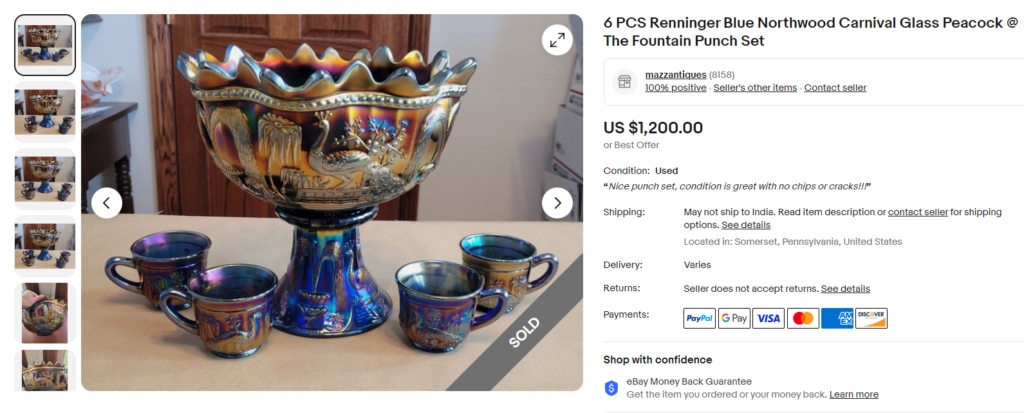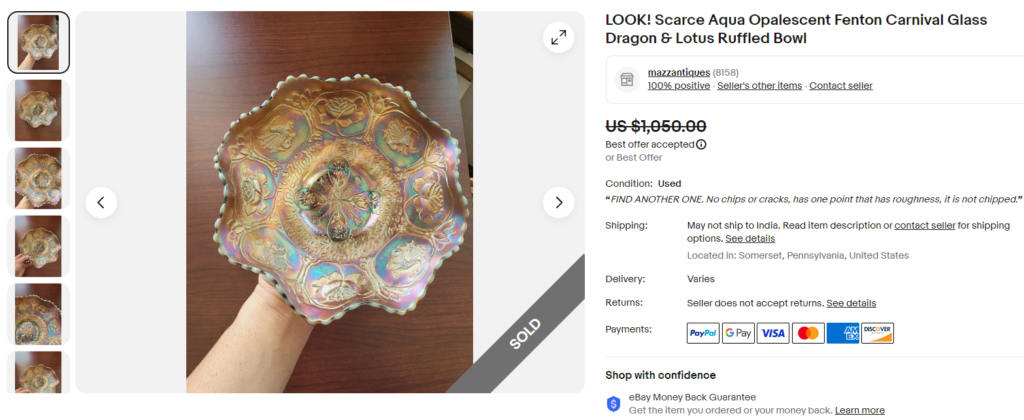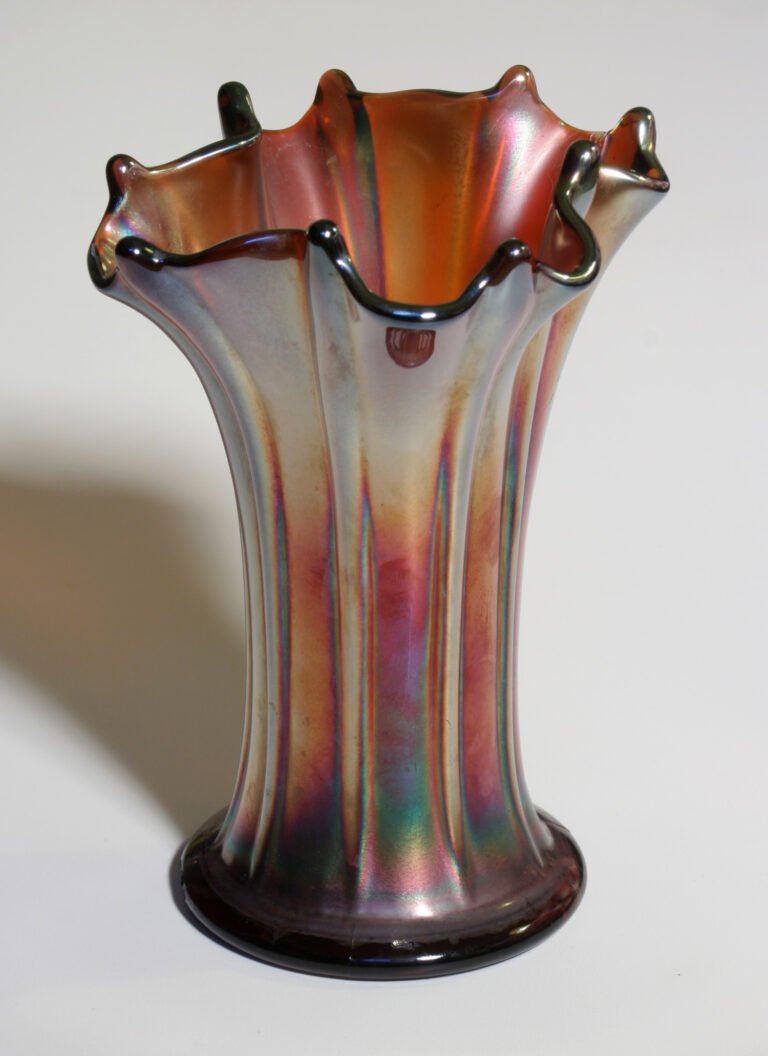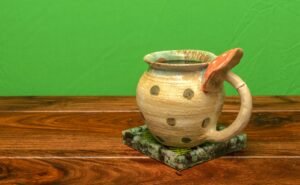Once distributed as free giveaways, the colorful and shiny vintage carnival glass pieces are precious collectibles that could be worth a fortune today! However, before buying or selling a specific piece, it’s helpful to find out if it’s really worth the money or just a common iridescent piece.
This value guide will help you evaluate the value of antique carnival glasses by identifying the age, condition, colors, and brand. I will also list the most valuable carnival glass pieces and give you tips to identify them, so you can find out if you own any of those precious gems!
A Brief About Iridescent or Carnival Glass
In 1908, Fenton Art Glass Company introduced iridescent glass, also known as carnival glass. Previously known as the “’Iridill,” “Venetian” or “Venice art glass,” the iridescent glass is known for its rainbowy shiny finish.
It became popular in the next 4-5 decades until the 1950s as “a poor man’s Tiffany.” During this time, all the leading glass manufacturers, including Northwood, Dugan, and Imperial, released many carnival glass items that became hits.
However, after the Great Depression, the iridescent ware was sold in bulk at carnivals and promotional gifts, which gave it the nickname Carnival Glass.
Assess the Value of Carnival Glass Pieces
The average value of carnival glass pieces is around $20 to $50 today, but some rare, distinctive pieces can be worth up to $3,000 or even more, as seen in several online sales and auction results.
So, what decides whether an antique carnival glass piece is valuable or not? Let’s understand!
1. Condition
The condition of a carnival glass piece is the make-or-break factor for common pieces. Damages like cracks, chipped edges, severe scratches, discoloration, lack of sheen, and etching can seriously depreciate the monetary value of a piece.
Collectors prefer more reflective and colorful pieces. That’s why the most reflective carnival glass (with the highest sheen), known as the “electric” carnival glass, usually fetches the highest bid at an auction.
However, if it’s an unusual, highly desirable, and rare piece, the condition becomes a secondary factor for valuation.
2. Rarity of Designs & Shapes
Carnival glass pieces that feature intricate patterns or designs that are not commonly found with a specific color or item can be extremely desirable and valuable. For example, Northwood’s strawberry pattern is hardly found on its ice-blue carnival glass, making it quite a rare piece.
Here are the few most popular carnival glass patterns:
- Dugan’s Farmyard
- Millersburg’s Blackberry Wreath
- Northwood’s Peacock
- Northwood’s Grape and Cable
- Fenton’s Strawberry Scroll
- Fenton’s Blueberry
3. Glass Colors
While you may find carnival glassware in several colors, only a few specific colors are worth a lot of money. Here are some rare and extremely popular carnival glass colors that fetch good returns.
- Cherry Red (Fenton)
- Marigold (
- Ambergina (Fenton Art Glass Company)
- Ice Blue (Northwood Glass Company)
- Black Amethyst (Northwood Glass Company)
- Ice Green (Northwood Glass Company)
4. Age
Naturally, older carnival glass pieces from the early 20th Century attract more collectors than the post-1930s pieces. You can estimate the age of a carnival piece by analyzing its making marks.
For example, if there are grooves at the bottom of the piece, it likely belongs to the early 1900s. Besides, if you can find the time during which a specific glass pattern was made, it may also help you age the piece.
Another sign of an aged piece is its naturally rusty appearance, which results from the aging metal oxide or salts used in glassmaking.
5. Glass Brand
Fenton Art Glass Co., which is the first glass company to produce carnival glass, made one of the most popular carnival glass pieces. Besides Fenton, the following brands are also highly sought after:
- Millersburg
- Northwood
- Dugan
- Imperial
- Robert Hanson
6. Item Size
Unusually large carnival glass items sell for higher prices than smaller ones. Similarly, complete sets, such as a 6-piece or 10-piece punch set, are worth much more than single pieces. The larger the sets, the more valuable it can be.
But remember, the rarity of the glass pattern and colors go side by side with size to determine the piece’s final value.
8 Most Valuable Carnival Glass Pieces Ever Sold!
Based on the above factors, some special antique carnival glass pieces can sell for exceptionally high prices, such as the following eight pieces:
1. Northwood Ice Blue Strawberry Carnival Glass Plate (Sold for $16,327)
While Northwood’s Strawberry pattern carnival glass is quite popular, it’s rarely seen in the ice blue color. That’s why one of the very few 9-inch Ice Blue Strawberry carnival glass plates with a sawtooth edge got the highest bid of $16,327 in an eBay auction in 2003.
A few years later, another rare ice blue strawberry bowl sold for $14,000 at the Southern California Carnival Glass Club auction, according to David Doty.
2. Dugan Farmyard Carnival Glass Bowl (Sold for $3,300)
One of the most expensive carnival glass pieces ever sold is an 11.5-inch purple Dungan Farmyard bowl with an eight-ruffle beaded edge. It features a jeweled heart exterior with a visible straw mark and seam at the base. It sold for a stunning price of $3,300 on LiveAuctioneers.
3. Dugan Farmyard Amethyst Carnival Glass Bowl (Sold for $2,100)
Another Dungan Farmyard carnival glass bowl with a six-ruffle beaded edge and jewel-heart external pattern was auctioned at $2,100. This proves that Dungan’s Farmyard is one of the most valuable patterns to look for on carnival glass pieces.
4. Millersburg 10-Piece Carnival Punch Set (Sold for $1,500)
A mint-condition Millersburg Amethyst punch set of 10 pieces, including a flared punch bowl, a base, and eight cups with the multi fruits and flower motifs sold for $1,500 on eBay.

5. Blue Northwood Peacock Carnival Glass Punch Set (Sold for $1,200)
A rare Renninger Blue Northwood Peacock punch set of 6 pieces sold for $1,200 on eBay. Peacock is one of Northwood’s most admired glass patterns. The piece is etched with an underscored “N” at the bottom, authenticating the brand.

6. Northwood Tree Trunk Carnival Glass Funeral Vase (Around $1,100)
This special 19.5-inch funeral carnival glass vase shaped like a tree trunk from Northwood is available at $1,100 on LiveAuctioneers. According to the auction details, this piece belongs to the Kansas Private Collection, making it rare and precious.
7. Eight Ruffled Fenton Carnival Glass Bowl (Sold for $1,050)
This aqua Fenton Carnival Glass bowl featuring the iconic dragon & lotus pattern sold for $1,050 on eBay. It displays a rare aqua color glass beneath the sheen and has an eight-ruffle beaded edge. Since Fenton did not make many aqua opal carnival bowls, this one is a rare find!

8. Northwood Marigold Carnival Glass Town Pump (Sold for $700)
Northwood’s Town Pump is one of the most desirable carnival glass items, and a town pump in Marigold is surely a rare find! Featuring autumn leaves patterns and an iridescent finish, this Art Nouveau piece sold for $700 on eBay recently.

How to Spot an Authentic Carnival Glass Piece
If spotting a real valuable carnival glass piece seems difficult, use the following features for easy identification.
Iridescence
Carnival glass is known for its iridescent sheen resembling a rainbow-like effect on the surface of the glass, which results from applying metallic salts during the glass manufacturing process.
Weight and thickness
Carnival glass is generally thicker and heavier than modern glassware due to the glassmaking processes used at the time. If it feels too light, it might be a reproduction or a fake.
Unique Uneven Edges
Unlike regular glassware that has plain edges, most carnival glass pieces often have uneven edges following unique patterns, like “ruffled,” “pie crust,” “sawtooth,” “ribbon,” or “ice cream.”
Manufacturers
One of the easiest ways to identify a carnival glass piece’s brand is by its marking at the bottom. For this purpose, you can refer to this makers’ marking guide.
However, this method may not always be helpful as only a few vintage carnival glass pieces have a marker’s mark etched on the base.
In this case, If you can find out the approximate manufacturing year or period of your carnival glass piece, it may help you identify its maker as well, by referring to the prominent brands working in that time frame.
Patterns & Designs
Old carnival glass pieces mostly feature intricate patterns and designs, such as flowers, fruits, geometric shapes, and animals. Each pattern has a distinctive look. So, it’s advisable to compare at least two to three pieces of the same pattern to ensure the carnival glass isn’t fake.
As you saw, some rare vintage carnival glassware items could be worth more than you think. So, whether you’re expanding your glass collection or are willing to sell out your old pieces, use this value guide to find the best price for them. Old milk glass pieces could also be highly desirable. Interested? Check out the most valuable milk glass pieces now!









